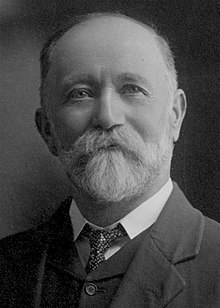William Guthrie Spence
|
The Honourable William Spence |
|
|---|---|
 |
|
| Member of the Australian Parliament for Darling |
|
|
In office 29 March 1901 – 5 May 1917 |
|
| Preceded by | New seat |
| Succeeded by | Arthur Blakeley |
| Member of the Australian Parliament for Darwin |
|
|
In office 30 June 1917 – 13 December 1919 |
|
| Preceded by | Charles Howroyd |
| Succeeded by | George Bell |
| Personal details | |
| Born |
7 August 1846 Eday, Scotland |
| Died | 13 December 1926 (aged 80) Terang, Victoria |
| Nationality | Scottish Australian |
| Political party |
Labor (1901–17) Nationalist (1917–19) |
| Spouse(s) | Ann Jane Savage |
| Occupation | Unionist |
William Guthrie Spence (7 August 1846 – 13 December 1926), Australian trade union leader and politician, played a leading role in the formation of both Australia's largest union, the Australian Workers' Union, and the Australian Labor Party.
Spence was born on the island of Eday in the Orkney Islands, Scotland, the son of a stonemason, and migrated to Australia with his family as a six-year-old child. He had no formal education and worked as a farm labourer in the Wimmera district of Victoria from the age of 13. Later he acquired a gold-mining licence and worked for various mining companies. In 1871 he married Ann Jane Savage.
In 1874 Spence was one of a number of militant mine-workers who formed the Amalgamated Miners' Association of Victoria, and he became the union's general secretary in 1882. He led the union into mergers with similar unions in the other Australian colonies, forming the Amalgamated Miners' Association of Australasia. In 1886, he became the first president of the Amalgamated Shearers' Union and by 1890 most shearers in South Australia, Victoria and New South Wales had joined the union and 85 per cent of the shearing sheds were open to union members only.
Since the Australian economy was expanding rapidly at this time and there was an acute shortage of labour, the unions were in a strong bargaining position and were able to secure great improvements in the living standards of Australia's rural working class. But the Depression which began in 1891 led to acute class conflict as the mine owners and graziers tried to cut wages to remain solvent in the face of falling commodity prices, and the unions resisted. In 1894 Spence led the amalgamation of the miners, shearers and other rural workers into the Australian Workers' Union (AWU), Australia's largest and most powerful union. There were bitter strikes in the maritime and pastoral industries, in which Spence played a leading role, although he was generally a force for moderation in the labour movement. He was the AWU's secretary from 1894 to 1898 and president from 1898 to 1917.
...
Wikipedia
